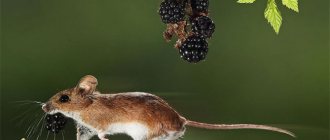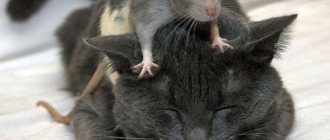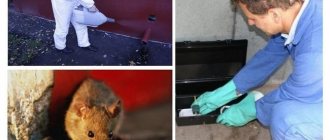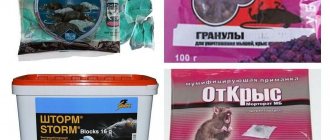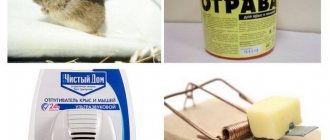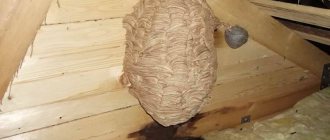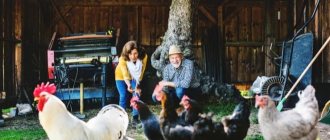There are more than 30 species of mice. The most common are the house mouse and the vole. Rodents cause a lot of harm: they spoil food in homes, pantries, and basements, they contaminate apartments, outbuildings and food products with feces, and they spread diseases. In the garden, voles damage plants, eat roots, tree bark, flower bulbs, fruits and vegetables. In buildings, rodents damage insulation and bite cables. Therefore, the fight against them must begin immediately. We will tell you how to get rid of mice in the house, at the dacha, on the site using folk remedies and using various methods.
Types of pest mice and their characteristics
First, you need to figure out what kind of enemy you will have to deal with, because, as they say: “mice differ among mice.”
House (house) mouse
Brownie - this does not mean at all that she lives only in human dwellings. A rodent may well be content with what it finds in the garden or vegetable garden: plant seeds, young shoots, tasty berries, small insects, their larvae, etc. When cold weather comes, rodents find a secluded place in dachas, in outbuildings, and here they already feel at ease and do not disdain anything: bulk products, vegetables and fruits, furniture, textiles, paper, plastic, insulation and even candles. The biggest problem is that they reproduce too quickly with a large number of offspring (10-12 litters per year, each with up to 12 cubs). Therefore, this problem cannot be downplayed.
Vole
The field mouse is visually similar to the house mouse and is directly and directly related to the hamster family. As a rule, it is these rodents that annoy owners of gardens and vegetable gardens. They very productively destroy or spoil succulent plant roots and young shoots, they like fleshy tubers and flower bulbs, and the animals will not refuse the bark of shrubs and trees, seeds and, of course, food supplies that they find in the house. When fighting them, it is important to take into account that they live in numerous colonies.
Shrew
Shrews, although similar to mice (they have a more elongated muzzle), belong to the shrew family and, by the nature of their activity, are more reminiscent of moles. They are carnivorous, feeding on insects, larvae and, in very rare cases, plants, but in search of food they can cause significant damage to the garden, plowing up the entire area and leaving plant roots without soil and nutrition. Perhaps not every owner has to deal with shrews, but some methods of dealing with mice also affect these animals.
LEAVE A REQUEST
WE WILL CALL YOU BACK WITHIN 15 MINUTES
- WE WORK FROM 8:00 TO 24:00
- FREE WARRANTY DEPARTURE
- QUALIFIED, GOOD MASTERS
Voles can cause significant damage in the garden, as well as significantly spoil supplies by getting into the cellar, pantry or house. Therefore, having discovered traces of an uninvited “guest” on the site or in the room, you should immediately decide how to get rid of the field mouse.
In the summer, the field mouse lives in areas with tall grass, where it builds nests and raises offspring
What danger do mice pose?
Mice are a real problem. Animals not only damage walls, furniture and clothing, they eat or infect food, “shit” everywhere, carry a “mouse” smell and breed in huge numbers. It would seem, what do tiny furballs with beady eyes and constantly moving antennae have in common with big problems or diseases? In fact, everything is very serious, because mice:
- Spoil or destroy food. And if fur, excrement or pieces of dead skin get into the latter, then there is a very high probability that people will experience food poisoning, allergic reactions, and exacerbations of diseases (for example, the respiratory tract).
- They can bring fleas into the house that carry dangerous infections to humans.
- They carry viruses and pathogenic bacteria that can cause dangerous diseases such as plague, typhoid, cholera, as well as various serious poisonings.
- They can cause a fire because they chew through wiring in places that, at first glance, seem completely inaccessible.
- They leave an unpleasant, specific, difficult-to-remove odor in the house.
CERTIFICATES
Field mice are rare guests of apartment buildings, but they can often be found in the attic or basement of a private house.
Due to the fact that voles prefer to live and breed in open biotopes, they are not attracted to stone cities, which cannot be said about gardening areas, meadows and bushes. As cold weather approaches, field mice begin to look for shelter where they can safely spend the winter. Warm wooden buildings are the best place for mice to spend the winter. That is why they regularly climb inside residential buildings. Cohabitation with wild mice cannot be called safe. In addition to the purely aesthetic problem associated with damage to property and mammal excrement, voles are carriers of serious infectious diseases, such as viral tick-borne encephalitis, Q fever, plague, rickettsiosis, tularemia, and rabies. In addition, small rodents are famous as notorious pests of grain crops. If they find supplies of food in the house, they will quickly destroy it.
What you need to know about mice?
Now we know what danger small rodents pose, but I would like to note a few more interesting points:
- The size of the animals is 6-10 cm, they have an excellent sense of smell, hearing, touch and taste.
- Running speed – 12-13 km/h, long jump – up to 75 cm, high jump – up to 40 cm.
- The animals are good at hiding, and a medium-sized animal can crawl through a 10-mm hole without any problems.
- In search of food, rodents do not go long distances from their nest and do not share their territory with rats.
- The incisor teeth of mice grow throughout their lives, and to prevent them from growing into the jaw, the animal must constantly chew something.
How can you tell if there are mice in your dacha?
The following signs may indicate that new residents have appeared in the house or nearby:
- The presence of minks near the walls of the house and outbuildings.
- Characteristic holes in the insulation or cladding of a building.
- Traces or already clearly visible paths near the wall.
- Bags or boxes containing various cereals or other products are damaged.
- Blankets, furniture, various textiles, including clothes, were damaged.
- Electrical wiring or even some pipes may be chewed.
- The harvest, which is already in the basement, has been gnawed.
- You can find droppings that have a specific smell both outside and inside the house.
- At night a characteristic squeak and rustling noise is heard.
- Fruits are spoiled, both fruits and vegetables, young plants, especially tulip and daffodil bulbs.
- Tree bark has been chewed.
- There is a regular shortage of eggs in the chicken coop.
- Domestic cats and dogs show anxiety and often sniff as if looking for someone.
If at least one of the listed points occurs, you need to urgently think about it and take effective measures to destroy or expel the mice. In this case, there is no time for thought and doubt. The fact is that rodents that enter a person’s house belong to a group of mice that always live next to people and are attached to them. Animals quickly adapt to any conditions and can easily tolerate heat, cold, heavy rainfall or prolonged lack of food.
Ways to fight
Now, knowing well who we are dealing with, we begin to act actively. The fight must be waged in two directions: prevention and direct destruction or expulsion. In order to correctly decide which method of warfare to choose, it is necessary to clarify some points:
- Room size and type.
- Volumes of food left for storage.
- The presence of children, sick people and pets in the house.
- Number of rodents detected.
No. 1. Chemical (poisons)
The method of chemical destruction of animals can be called one of the most effective. There are a considerable number of different poisons, which are:
- Inorganic (contains heavy metals, causes severe intoxication, large quantities are required).
- Organic (a small amount is enough).
- Cumulative action (gradually accumulate in the rodent’s body, leading to disruption of the functioning of various organs of the animal and their subsequent failure).
- Fast-acting (acts on mice almost instantly).
Chemical mice control agents vary in release form . It can be:
- Powders are indispensable for preparing baits that will attract rodents to a meal of poisoned products.
- Gels and creams can attract the attention of many rodents at once. Chemicals with flavor additives and various strong flavors can be used for a long time without loss of effectiveness.
- Tablets and briquettes , as a rule, have a bright color and an attractive (for mice) odor. They are convenient to use in places that are difficult for humans to reach.
- Liquid poison is mixed into the water, while limiting the access of pest animals to other sources of drinking.
- Sprays and aerosols are mainly used by humane owners of dachas, vegetable gardens and gardens. Drugs whose active ingredients are methyl salicylate and nonivamide cause nausea, vomiting in rodents and force them to retreat from the area they like.
It is important to consider that repellent substances do not poison mice or reduce their numbers, but simply force them to leave a specific territory, and therefore move to another
The most effective poisons include:
- “Death of the Rat”, “Biorat”, “Storm”, “Nutcracker”. The active ingredient in the drugs is brodifacoum , which causes suffocation and internal bleeding. Animals die 7 days after taking the bait.
- “Zookoumarin Neo”, “Zoopasta” is an anticoagulant , a highly toxic poison, and is a mummifying agent.
- “3D-Ratsid”, “Antirodent”, “Blockade”, “Absolon”, “Clean House”, “Rattidion” are much more toxic than the previous drug; their active ingredient is bromadiolone , a second-generation anticoagulant.
- “Ratindan”, “MEF”, “Rotendant” are some of the most toxic drugs, the active ingredient of which is diphenacin . In powder form, it is dangerous for both animals and people.
- The “Efa” remedy is grains soaked in poison. The basis of the highly toxic poison is ethylphenacin , so it is important that the product does not come into contact with human skin. The drug has proven itself well with long-term use.
- “Tsunami”, “Tsunami-Extra”, “Ratol” are considered one of the best accumulative products for rodent control. The active basis of special tablets disrupts the functioning of the circulatory and cardiac systems of the rodent, while the drug is harmless to humans.
Products such as “Mortorad”, “Storm”, “Mouse Death”, “Nutcracker”, “Rat Death” are positioned by stores as mummifying. In any case, these are the five most effective means for use in the countryside, if you do not take into account the drugs used by professional specialized services: “Goliath” or “Deratomin”.
For those who decide to fight rodents using poisons, it is important to observe the necessary precautions as much as possible, carefully study the manufacturer’s recommendations, as well as carefully prepare the room itself and be sure to take care of the safety of people and pets
Recipes for poisons “from the people”:
- Sugar – 1 part, flour – 2 parts, gypsum – 6 parts (you can mix flour and putty) or make a mixture of sugar, flour and soda.
- Powdered sugar – 1 part, flour – 2 parts, quicklime – 6 parts.
The baits made in this way are thrown to the mice and they eat them with pleasure. Be sure to put water nearby. When the mixture enters the animal’s stomach, in the first case, it hardens, clogging the digestive organs; in the second, it corrodes their mucous membrane.
- The cork stopper from wine or champagne is finely chopped and fried in oil. The mouse eats this treat and gets indigestion and a sad end.
- The same cork can be crushed and “camouflaged” by mixing it with some kind of cereal.
- Barium carbonate (5 g), flour (20 g) and melted fat (30 g) are mixed to produce a poisonous mixture from which the balls are formed. The latter are best placed near rodent burrows.
- Prepare a “treat” from gypsum, dry potatoes and cinnamon.
- A mixture of dry putty and flour (1:1) with the addition of salt and water.
- Foam rubber cut into small pieces and soaked in aromatic sunflower oil is suitable.
No. 2. Repellers
Technology does not stand still and many companies offer a considerable selection of devices that are quite effective in the fight against small rodents and at the same time completely safe for both animals and people. When choosing a suitable device, you need to take into account its main characteristics:
- Safety and ease of use.
- Availability of a power source.
- Signal frequency.
- Maximum effective range.
We are talking about special repellers:
Ultrasonic
The ultrasonic pulse that the device sends disorients the mice, causes them to panic, fear and forces them to leave the area where the seal is spreading. Humans cannot hear or perceive high-frequency vibrations, but they cause a lot of inconvenience to rodents. The main advantages of such devices include:
- Convenience and ease of use.
- Use for a long period of time without interruption.
- Environmentally friendly.
- Safety for humans and pets (note: ornamental rodents are at risk).
- As an added bonus, it is effective against mosquitoes, flies and other flying squirrels.
To prevent small pests from getting used to the generated sound, as a rule, its frequency periodically fluctuates between 20 kHz and 70 kHz. In addition, models have been released that are equipped with light indicators - flashes that appear randomly not only blind mice, but also do not allow them to navigate well in space.
They have high-frequency devices and small “ cons ” that you need to be aware of when choosing a particular device:
- A large number of textiles, upholstered furniture, paper products and other similar items in the room reduce the efficiency of the device, since they all actively absorb ultrasound.
- The pulse that the repeller sends cannot pass through the walls, but is only reflected from them, so the action of the device is limited to the walls of a particular room.
Conclusion: the fewer obstacles in the path of ultrasound, the better. And there is no need to rush into results. Despite the fact that the device begins to operate from the first minutes, to completely expel rodents, the repeller will require constant operation for several days, or even weeks.
The following received good ratings from users:
- Model range “Tornado” and “Typhoon” (the devices have a wide frequency range and are effective when working in both large and small rooms.
- The “Grad” series of devices (have a distinctive sound sequence, can operate from different power sources (mains, batteries, accumulator), some devices additionally have bright LEDs).
- The Chiston line of devices (using a continuous supply of a powerful signal, which allows you to expel rodents as quickly as possible).
- “ElectroKot”, “Ecosniper” (working in several modes is possible - pulsed, continuous and combined).
- "Weitech" (easy to use, affordable, compact in size, universal mouse and insect repeller) and many others.
Electromagnetic
For the operation of electromagnetic devices, it is necessary to have electrical wiring through which impulses are transmitted. The radiation emitted by the devices affects rodents in a similar way to ultrasonic repellers: they cause anxiety and discomfort in animals, and panic attacks force mice to leave their homes. Advantages:
- Environmentally friendly and free of harmful substances.
- Long work without breaks.
- No absorption of impulses by upholstered furniture and textiles.
- Large coverage area (without compromising the operation of various electrical appliances).
- The ability to influence rodents in the voids of walls and ceilings.
- Strike at crawling insects.
As for the shortcomings . The main and very significant problem is the need for wiring, which must be laid along the perimeter of the entire room, in extreme cases - at least along the longest wall. If this condition is not met, all efforts will be in vain.
The most popular and effective models:
- “Riddex Plus” - the device has a plastic impact-resistant case, is resistant to humidity - up to 90% and temperature changes - from -35 to + 45 ° C, the repeller coverage area is 80-200 sq. m.
- "EMR-21" is a reliable device with a light indicator, operating within a radius of 230 square meters. m.
- “Digital” is a budget version of the repeller with a range of 80 square meters. m. Perfect for a summer cottage.
- “Range 3”, “Yastreb 200” is a convenient compact model with enough power to be used in both small and large areas.
Combined
Obviously, the best choice is combined devices that combine all the “advantages” of the two previous varieties. And, although the price of the proposed devices is a little higher, it is more than compensated by their versatility and speed of action. It's worth noting here:
- "Chiston-2".
- "Tornado 1200".
- Riddex Quad.
- "Ultrasonic Rodent Repeler"
No. 3. Mechanical (traps and mousetraps)
Mechanical methods of exterminating rodents today do not lose their relevance and, on the contrary, are being improved and modified. The list of designs is considerable and I would like to take a closer look at it. So:
Mousetrap with frame
A well-known device for catching rodents. A steel frame, which kills the rodent, and a spring are fixed on a wooden base (can be plastic or metal). This design has been well known to everyone for a long time, so many people know that it can often:
- Jam.
- Simply record a “false call” while the mouse manages to drag away the bait.
- Not particularly effective in case of massive pest infestations.
In addition, we should not forget that the animal’s corpse must be removed from the mousetrap and disposed of. But not everyone can do this.
Tube mousetrap
This invention can be safely used by people who experience panic horror, both in front of living and dead animals. An opaque plastic pipe, a bait and a mechanism that does not allow the animal to get back out are simple components, the effect is obvious, and the visual result does not cause disgust. An additional design element in the form of a striking device is possible.
Swing trap
This device is called differently: “swing”, “springboard”, “water captivity”, etc. But the principle of operation is the same everywhere, and the trap itself is quite effective - in a short period of time you can catch a large number of small rodents. Making the design yourself will not be difficult. For this you need:
- Any container such as a bucket, spacious, which will serve as the basis of the trap.
- The lath is thin, you can even use a ruler.
- A knitting needle or wire that does not bend.
During the assembly process, the wire is securely fixed perpendicular to the rail. The resulting element is installed on the bucket so that the “swing” ruler touches only one of its edges. A rodent bait is attached to its other end. And then the structure is installed in the right place so that the animals can freely enter the springboard from a stable side and move straight into the trap. Very often the bucket is not left empty, but some water is poured into it.
Trap with loop
The device is really very simple in design. As a rule, this is a wooden block with one or more holes. Loops made of very thin but strong wire are fixed with a thread inside the “mink”. Since the mouse will have to chew the thread to get to the “yummy”, it itself will launch the mechanism of its destruction - the noose will kill it in any case.
Traps and cages
Both traps were borrowed from hunters:
- In the first case, we are talking about mini-analogues of traps for large predators. The design includes: a solid base, which has sharp teeth around the perimeter, a cocking mechanism and a bait located inside the device.
- In the second, it is the most ordinary cage made of steel, small in size, with a hook inside for securing treats and an automatic door. The latter is triggered when the mouse wants to steal food.
The second device, unlike the first, refers to humane methods of getting rid of rodents. The captured animals are not physically harmed and can be released into the wild as far as possible from their home.
One of the popular models is the “House” plastic trap. The tube has a certain bending angle and two doors - at the beginning of the structure and at the end. In the depths, near the back cover, some mouse delicacy is placed and the front door opens. When the rodent approaches the bait, the front door slams (automatically). All that remains is to release the small pest in time.
Bottle trap
A simple device that any craftsman can do. A glass or plastic bottle with a volume of 0.5 to 2 liters is suitable, inside of which you can pour a little sunflower oil, sprinkle some seeds, and, in general, put bait. Then the bottle must be installed at an angle so that the neck is higher, fixed, and you can even make some kind of steps for the mice. Slowly, but confidently, the goal will be achieved.
Live trap jar
To organize a trap, you need to take a glass jar and a coin or a piece of cardboard with a small notch. The jar is turned upside down, a treat for the animal is placed inside, one edge of the jar is raised and placed on the edge of a coin or a vertically placed piece of cardboard. Everything must be done very carefully, because the structure turns out to be very unstable and it will not be difficult to upset the balance even for a small mouse, which is immediately caught.
Electric mouse trap
Today, not the last place among the effective traps is occupied by electric mousetraps. They are much better than their mechanical brothers and sisters. In order for the trap to start working, you need to fill it with bait and connect it to the power system (electrical network). There are live contacts inside the device. The animal, making its way to the treat, will certainly touch them and be killed by an electric shock. Most models are equipped with signal LEDs to notify you when the device is triggered.
Glue traps
When talking about methods for catching mice, we cannot ignore glue traps. Such devices are not humane, but they are among a number of popular and budget-friendly methods of exterminating rodents. Everything is quite simple. Thick cardboard strips are covered with a layer of fragrant glue. Moreover, the aromas can be very diverse, the main thing is that they attract animals. And those, following the smell, fall into a trap - a sticky layer from which they are not destined to escape.
In many cases, you can use not only ready-made traps, but also separately glue in a tube for rodents. You can apply it in different places and be especially careful not to get caught yourself.
No. 4. People's
Everything that is not manufactured on an industrial scale in finished or semi-finished form can be classified as folk methods of fighting mice. The most popular options are listed below:
- Wood ash greatly irritates the paws of animals, and they also find its smell unpleasant. Therefore, if you scatter it on mouse paths and hard-to-reach places, rodents will begin to avoid them.
- The burdock thorns will not allow the animals to enter the dacha, since they firmly cling to the animals’ fur coat, which does not make the latter happy at all.
- It would not be superfluous to treat the entrances to burrows and walls with bleach .
- branches of wild rosemary, black currant or coniferous trees not only directly next to the burrows, but also to insert them deeper into them. Such a scented barrier will repel rodents, and spruce or pine paws will also become an obstacle to movement.
- Mice cannot tolerate essential oils of wormwood, mint or elderberry If you put rags on which the listed oils are applied into the minks, most likely the mice will run away from their “familiar nests” and will definitely not appear in these places for a couple of months. This remedy is excellent for prevention.
- hot pepper (the so-called “smoking”) gives good results A large pepper pod is wrapped in several layers of newspaper, placed in some container (for example, a basin) and set on fire. There is no need to start a fire, but it is advisable to let the smoke sit in the room for a couple of days. The method is relevant for expelling rodents from basements and cellars.
- Similar to the previous method, the desired result can be achieved using a sulfur bomb. After its smoldering, the room is not ventilated for 1-2 days, and the mice flee as if “from a sinking ship.”
- You can scare away pests using Vishnevsky ointment or birch tar . You just need to treat the baseboards, thresholds, and the lower part of the furniture with them.
- To protect the area from small rodents, the following are suitable: reeds, pine branches, fabric soaked in kerosene or creolin, sawdust, tomato tops and elderberries. Along the perimeter of the territory it would not hurt to plant spurge, black root, cilantro (coriander), wormwood, mint or black currant.
- In the house, it is worth laying out on bedside tables, in cabinets, in corners or along the walls: garlic, tansy, chamomile, drop a little peppermint alcohol or peppermint oil.
No. 5. Biological
This paragraph is dedicated to animals that can be attracted to catch rodents. There are, in fact, quite a few options: cats, ferrets, hunting dogs (fox terrier, dachshund).
- First of all, of course, we are talking about cats and cats. By the way, it has been noticed that cats are more responsible hunters than cats. And the simplest mongrel cats, without regalia or family coats of arms, do the best job with this kind of work. But those who want to have a purebred animal and take it with them to the dacha to catch mice should pay attention to such breeds as Siberian, Kuril Bobtail, Russian Blue, Maine Coon, Bengals and Siamese, British Shorthairs, Abyssinians, etc.
- Ferrets are also super mousecatchers . These small, very nimble animals are a nightmare for small rodents. These animals can easily find a common language with dogs and cats, but if there are chickens on the farm, you should immediately refuse the helper of the mustelid family, without even thinking about it.
- Many representatives of the dog world are excellent rat catchers, but if a mouse comes across their path, it has no chance of salvation. The most avid hunters of small rodents are: some breeds of terriers and dachshunds, miniature pinschers, fox terriers, and rat catchers (Andalusian and Prague rat rats).
If someone wants to really surprise all their neighbors, let them get themselves a pet owl , which is also not averse to profiting from small animals. The main thing is to provide that both a kitten and a small puppy can fall into her paws, but there will definitely be no mice.
How to prevent the appearance of rodents?
Some may think that the war with mice is impossible to win. In fact, getting rid of rodents is quite possible, and with modern “helpers” it won’t be difficult at all. It is not necessary to use any one method; they can be combined, the most suitable option can be selected, new developments can be added to well-known methods, etc. If you constantly maintain order in the area and carry out preventive work, the fight against rodents will certainly be crowned with success. To do this you need:
- Harvest in a timely manner.
- Do not leave grass clippings or mulch on the property.
- Burn dry grass and plow the ground. Digging will destroy the nests of animals.
- Water the remaining beds with cold water or a mixture of water and chicken droppings.
- Seal cracks in the house and close ventilation holes.
- Store products well closed in glass or durable plastic containers.
- Plant mint and lemon balm between the house and other buildings.
- Use repellers.
Everyone can resist a rodent infestation. Don’t give up, but rather stock up on patience, useful tips, available materials and popular industrial products – and everything will work out!
The article was written for the site.
Tags: Pest control, Dacha
Prevention measures
There are ways to prevent rodents from entering dacha plots. Such events include:
- Prevent the accumulation of garbage on the site, adhering to the main rule - keeping the site clean.
- Practice using Storm tablets. They should be placed in places where the crop is stored.
- Use sticky traps throughout the year.
The vole mouse is a dangerous rodent that needs to be dealt with, as it can ruin most of the crop.
How to get rid of mice, fantastic!
